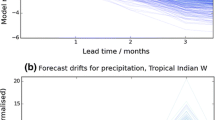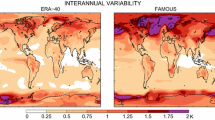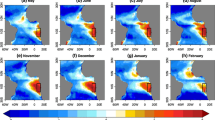Abstract
Climate models are often affected by long-term drift that is revealed by the evolution of global variables such as the ocean temperature or the surface air temperature. This spurious trend reduces the fidelity to initial conditions and has a great influence on the equilibrium climate after long simulation times. Useful insight on the nature of the climate drift can be obtained using two global metrics, i.e. the energy imbalance at the top of the atmosphere and at the ocean surface. The former is an indicator of the limitations within a given climate model, at the level of both numerical implementation and physical parameterisations, while the latter is an indicator of the goodness of the tuning procedure. Using the MIT general circulation model, we construct different configurations with various degree of complexity (i.e. different parameterisations for the bulk cloud albedo, inclusion or not of friction heating, different bathymetry configurations) to which we apply the same tuning procedure in order to obtain control runs for fixed external forcing where the climate drift is minimised. We find that the interplay between tuning procedure and different configurations of the same climate model provides crucial information on the stability of the control runs and on the goodness of a given parameterisation. This approach is particularly relevant for constructing good-quality control runs of the geological past where huge uncertainties are found in both initial and boundary conditions. We will focus on robust results that can be generally applied to other climate models.









Similar content being viewed by others
References
Adcroft A, Campin JM, Hill C, Marshall J (2004) Implementation of an Atmosphere ocean general circulation model on the expanded spherical cube. Mon Weather Rev 132:2845. doi:10.1175/MWR2823.1
Anderson DE, Cahalan RF (2005) The solar radiation and climate experiment (SORCE) mission for the NASA earth observing system (EOS). Solar Phys 230:3–6
Braconnot P, Harrison SP, Otto-Bliesner B, Abe-Ouchi A, Jungclaus J, Peterschmitt JY (2011) The paleoclimate modeling intercomparison project contribution to CMIP5. CLIVAR Exch No 56(16):15–19
Brunetti M, Vérard C, Baumgartner PO (2015) Modeling the middle jurassic ocean circulation. J Palaeogeogr 4:373–386
Campin JM, Marshall J, Ferreira D (2008) Sea ice-ocean coupling using a rescaled vertical coordinate z*. Ocean Model 24:1–14. doi:10.1016/j.ocemod.2008.05.005
Covey C, Gleckler PJ, Phillips TJ, Bader DC (2006) Secular trends and climate drift in coupled ocean-atmosphere general circulation models. J Geophys Res 111(D03):107. doi:10.1029/2005JD006009
Fasullo JT, Trenberth KE (2008) The annual cycle of the energy budget. Part II: meridional structures and poleward transports. J Clim 21:2313. doi:10.1175/2007JCLI1936.1
Freire JG, Bonatto C, DaCamara CC, Gallas JAC (2008) Multistability, phase diagrams, and intransitivity in the Lorenz-84 low-order atmospheric circulation model. Chaos 18(3):033121. doi:10.1063/1.2953589
Gent PR, McWilliams JC (1990) Isopycnal mixing in ocean circulation models. J Phys Oceanogr 20:150–160
Gent PR, Danabasoglu G, Donner LJ, Holland MM, Hunke EC, Jayne SR, Lawrence DM, Neale RB, Rasch PJ, Vertenstein M, Worley PH, Yang ZL, Zhang M (2011) The community climate system model version 4. J Clim 24:4973–4991. doi:10.1175/2011JCLI4083.1
Golaz JC, Golaz JC, Levy H (2013) Cloud tuning in a coupled climate model: impact on 20th century warming. Geophys Res Lett 40:2246–2251. doi:10.1002/grl.50232
Gregoire LJ, Valdes PJ, Payne AJ, Kahana R (2011) Optimal tuning of a GCM using modern and glacial constraints. Clim Dyn 37(3):705–719. doi:10.1007/s00382-010-0934-8
Hansen J, Russell G, Rind D, Stone P, Lacis A, Lebedeff S, Ruedy R, Travis L (1983) Efficient three-dimensional global models for climate studies: model I and II. Month Weather Rev 111:609–662
Hansen J, Sato M, Kharecha P, von Schuckmann K (2011) Earth’s energy imbalance and implications. Atmos Chem Phys 11:13,421–13,449. doi:10.5194/acp-11-13421-2011
Hobbs W, Palmer MD, Monselesan D (2016) An energy conservation analysis of ocean drift in the CMIP5 global coupled models*. J Clim 29:1639–1653. doi:10.1175/JCLI-D-15-0477.1
Hourdin F, Mauritsen T, Gettelman A, Golaz J, Balaji V, Duan Q, Folini D, Ji D, Klocke D, Qian Y, Rauser F, Rio C, Tomassini L, Watanabe M, Williamson D (2017) The art and science of climate model tuning. Bull Am Meteorol Soc 98:589–602. doi:10.1175/BAMS-D-15-00135.1
Howell FW, Haywood AM, Otto-Bliesner BL, Bragg F, Chan WL, Chandler MA, Contoux C, Kamae Y, Abe-Ouchi A, Rosenbloom NA, Stepanek C, Zhang Z (2016) Arctic sea ice simulation in the PlioMIP ensemble. Clim Past 12:749–767. doi:10.5194/cp-12-749-2016
Irvine PJ, Gregoire LJ, Lunt DJ, Valdes PJ (2013) An efficient method to generate a perturbed parameter ensemble of a fully coupled aogcm without flux-adjustment. Geosci Model Devel 6:1447–1462. doi:10.5194/gmd-6-1447-2013
Jakob C (2014) Going back to basis. Nat Clim Change 4:1042–1045
Kucharski F, Ikram F, Molteni F, Farneti R, Kang IS, No HH, King MP, Giuliani G, Mogensen K (2016) Atlantic forcing of Pacific decadal variability. Clim Dyn 46:2337–2351. doi:10.1007/s00382-015-2705-z
Kucharski F, Molteni F, Bracco A (2006) Decadal interactions between the western tropical Pacific and the North Atlantic oscillation. Clim Dyn 26:79–91. doi:10.1007/s00382-005-0085-5
Kucharski F, Molteni F, King MP, Farneti R, Kang I-S, Feudale L (2013) On the need of intermediate complexity general circulation models: a “SPEEDY” example. Bull Am Meteor Soc 94:25–30
Landrum L, Holland MM, Schneider DP, Hunke E (2012) Antarctic sea ice climatology, variability, and late twentieth-century change in CCSM4. J Clim 25:4817–4838. doi:10.1175/JCLI-D-11-00289.1
Large WG, McWilliams JC, Doney SC (1994) Oceanic vertical mixing: a review and a model with a nonlocal boundary layer parameterization. Rev Geophys 32:363–404. doi:10.1029/94RG01872
Levitus S, Boyer T (1994) World ocean atlas 1994. Temperature, vol 4. U.S. Department of Commerce, Washington, DC
Levitus S, Burgett R, Boyer T (1994) World ocean atlas 1994. Salinity, vol 3. U. S. Department of Commerce, Washington, DC
Lucarini V, Pascale S (2014) Entropy production and coarse graining of the climate fields in a general circulation model. Clim Dyn 43:981–1000. doi:10.1007/s00382-014-2052-5,1304.3945
Lucarini V, Ragone F (2011) Energetics of climate models: net energy balance and meridional enthalpy transport. Rev Geophys 49:RG1001. doi:10.1029/2009RG000323
Lunt DJ, Huber M, Anagnostou E, Baatsen MLJ, Caballero R, DeConto R, Dijkstra HA, Donnadieu Y, Evans D, Feng R, Foster GL, Gasson E, von der Heydt AS, Hollis CJ, Inglis GN, Jones SM, Kiehl J, Kirtland Turner S, Korty RL, Kozdon R, Krishnan S, Ladant JB, Langebroek P, Lear CH, LeGrande AN, Littler K, Markwick P, Otto-Bliesner B, Pearson P, Poulsen CJ, Salzmann U, Shields C, Snell K, Stärz M, Super J, Tabor C, Tierney JE, Tourte GJL, Tripati A, Upchurch GR, Wade BS, Wing SL, Winguth AME, Wright NM, Zachos JC, Zeebe RE (2017) The DeepMIP contribution to PMIP4: experimental design for model simulations of the EECO, PETM, and pre-PETM (version 1.0). Geosci Model Dev 10:889–901. doi:10.5194/gmd-10-889-2017
Marshall J, Adcroft A, Hill C, Perelman L, Heisey C (1997a) A finite-volume, incompressible Navier Stokes model for studies of the ocean on parallel computers. J Geophys Res 102:5753–5766. doi:10.1029/96JC02775
Marshall J, Hill C, Perelman L, Adcroft A (1997b) Hydrostatic, quasi-hydrostatic, and nonhydrostatic ocean modeling. J Geophys Res 102:5733–5752. doi:10.1029/96JC02776
Marshall J, Adcroft A, Campin JM, Hill C (2004) Atmosphere-ocean modeling exploiting fluid isomorphisms. Month Weather Rev 132:2882–2894
Mauritsen T, Stevens B, Roeckner E, Crueger T, Esch M, Giorgetta M, Haak H, Jungclaus J, Klocke D, Matei D, Mikolajewicz U, Notz D, Pincus R, Schmidt H, Tomassini L (2012) Tuning the climate of a global model. J Adv Model Earth Syst 4:M00A01. doi:10.1029/2012MS000154
Molteni F (2003) Atmospheric simulations using a GCM with simplified physical parametrizations. I: model climatology and variability in multidecadal experiments. Clim Dyn 20:175–191
National Research Council (2011) Understanding earth’s deep past: lessons for our climate future. The National Academies Press, Washington, D.C. doi:10.17226/13111
Nguyen AT, Menemenlis D, Kwok R (2011) Arctic ice-ocean simulation with optimized model parameters: approach and assessment. J Geophys Res (Oceans) 116:C04025. doi:10.1029/2010JC006573
Palmer MD, McNeall DJ (2014) Internal variability of Earth’s energy budget simulated by CMIP5 climate models. Environ Res Lett 9(034):016. doi:10.1088/1748-9326/9/034016
Pascale S, Gregory JM, Ambaum M, Tailleux R (2011) Climate entropy budget of the HadCM3 atmosphere-ocean general circulation model and of FAMOUS, its low-resolution version. Clim Dyn 36:1189–1206. doi:10.1007/s00382-009-0718-1
Sanchez-Gomez E, Cassou C, Ruprich-Robert Y (2016) Drift dynamics in a coupled model initialized for decadal forecasts. Clim Dyn 46:1819–1840
Sellwood BW, Valdes PJ (2008) Jurassic climates. Proc Geol Assoc 119:5–17
Sen Gupta A, Muir LC, Brown JN, Phipps SJ, Durack PJ, Monselesan D, Wijffels SE (2012) Climate drift in the CMIP3 models. J Clim 25:4621–4640
Sen Gupta A, Jourdain NC, Brown JN, Monselesan D (2013) Climate drift in the CMIP5 models. J Clim 26:8597–8615
Tang Y, Li L, Dong W, Wang B (2016) Reducing the climate shift in a new coupled model. Sci Bull 61:488–494. doi:10.1007/s11434-016-1033-y
Trenberth KE, Fasullo JT, Balmaseda MA (2014) Earth’s energy imbalance. J Clim 27:3129–3144. doi:10.1175/JCLI-D-13-00294.1
Wielicki BA, Barkstrom BR, Harrison EF, Lee RB III, Smith GL, Cooper JE (1996) Clouds and the earth’s radiant energy system (CERES): an earth observing system experiment. Bull Am Meteorol Soc 77:853–868
Wild M, Folini D, Schär C, Loeb N, Dutton EG, König-Langlo G (2013) The global energy balance from a surface perspective. Clim Dyn 40:3107–3134. doi:10.1007/s00382-012-1569-8
Winton M (2000) A reformulated three-layer sea ice model. J Atmos Ocean Technol 17:525–531
Acknowledgements
The computations were performed at University of Geneva on the Baobab and CLIMDAL3 clusters. We thank Jean-Michel Campin, Marjorie Perroud and Martin Beniston for useful discussions, and the MITgcm-support mailing list for valuable advice on the code. This work was partly supported by CTI 15574.1 PFES-ES.
Author information
Authors and Affiliations
Corresponding author
Rights and permissions
About this article
Cite this article
Brunetti, M., Vérard, C. How to reduce long-term drift in present-day and deep-time simulations?. Clim Dyn 50, 4425–4436 (2018). https://doi.org/10.1007/s00382-017-3883-7
Received:
Accepted:
Published:
Issue Date:
DOI: https://doi.org/10.1007/s00382-017-3883-7




